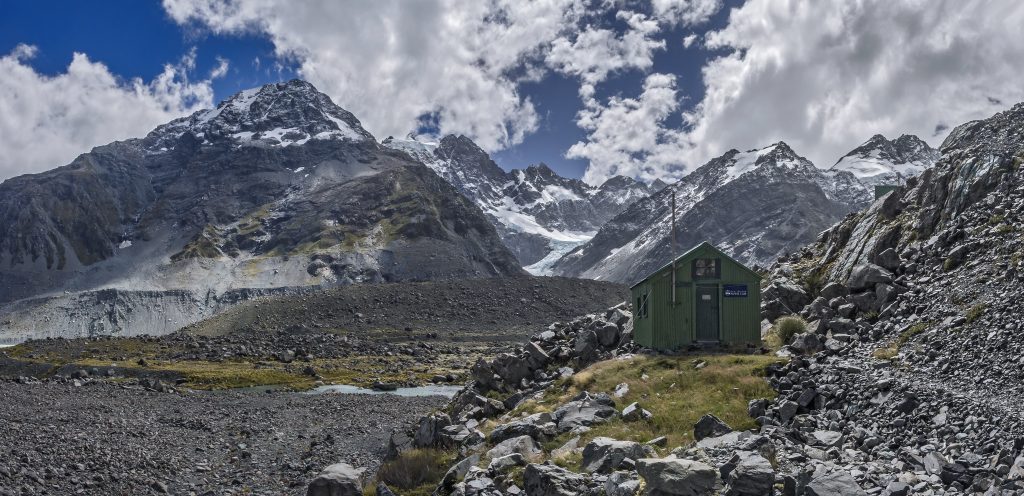With the closure of another hut in Aoraki/Mt Cook National Park, George Driver investigates the challenge of keeping a foothold in one of the most rapidly changing landscapes on Earth
Looking at Murchison Hut, you’d have no inkling it may soon tumble 200m onto Murchison Glacier in one of the largest landslides in the Southern Alps’ recent history. But, by a strange series of events, scientists discovered the hut had moved a massive nine metres downwards, and nine metres sideways as a huge chunk of the mountain has started to collapse.
University of Otago surveying lecturer Dr Pascal Sirguey has become an expert in accurately surveying the Southern Alps. The Frenchman led the project which saw the height of Aoraki/Mt Cook revised down from 3754m to 3724m in 2014. But, sitting at his desk in Dunedin, he never thought his work would have life-saving consequences. Sirguey’s latest project involves using highly detailed satellite imagery to study glacial wasting in the Alps.
While comparing aerial surveys from 2008 with satellite imagery from February 2017, he noticed something odd.
“We use control points on the ground to line up the two sets of imagery and everything was lining up perfectly, but at that point [beside Murchison Hut] I just couldn’t get it right,” Sirguey says.
After working for a couple of weeks to make sure there were no errors, he confirmed that the side of Mt Cooper (2362m), on which Murchison Hut is poised, was dangerously unstable – the bedrock was cracking.
“I called GNS and said ‘you’ve got to check this out’. I was pretty sure I was looking at something endangering public safety.”
The hut was closed on August 30 this year and the New Zealand Alpine Club, which owns the hut, is deciding its fate.
GNS structural geologist Simon Cox, who has been working in the Southern Alps for 32 years, says if the unstable rock all went at once, it would be among the biggest landslides ever recorded in the Alps. In a back-of-the-envelope calculation, Cox says the landslide could involve up to 10 million cubic metres of rock – by comparison, the Aoraki/Mt Cook rock avalanche in 1991 was 12 million cubic metres.
So, what caused the mountainside to weaken to the point of collapse? Sirguey’s research found Murchison Glacier has thinned by about 30m in the past decade, which could explain what caused the bedrock to fail. Cox says the glacier effectively buttressed the rock on the side of the valley and, now it’s gone, the whole mountainside has been weakened.
“Murchison Hut isn’t an isolated example,” Cox says. “It’s a very common process – as the ice melts and retreats, it removes the support for the slopes above and the mountain starts collapsing.”
Sirguey says the findings may be a world first in the use of highly-detailed satellite imagery and the experience has unlocked a whole new use for the technology.
“A leading researcher in the use of satellite imagery said he had never heard of satellite images being used like this,” Sirguey says. “It was a pure coincidence, but a striking example of the potential of this kind of processing and data. We hope this has literally saved lives.”
The images could be used in the future to assess the risk of other landslides near huts, though the images, produced by French Pleiades satellites, and processing software cost tens of thousands of dollars.
Murchison Hut joins Hooker, De la Beche, Gardiner and Haast huts which have all closed in the last five years. GNS is also actively monitoring Mueller Hut, as there is a “slow, creeping landslide” from the ridge in front of the hut, down to Mueller Glacier.
“It’s moving as a result of the downwasting of the Mueller Glacier, similar to what’s happening at Murchison Hut,” Cox says. “The difference is the rate of the slip isn’t as high, the angle isn’t as steep, and the glacier below the hut receded some time ago, so it’s had time to adjust.
“We are watching the cracks in the region of the hut and tracking any changes.”

It’s an issue which is likely to keep recurring. Cox says the rate of landslides in the Southern Alps has increased exponentially over the past 50 years due to a combination of climate change, intense rainfall and plate tectonics. “With about 10m of precipitation a year, the Southern Alps has one of the highest rates of erosion in the world,” he says.
Cox also says an increase in earthquakes, like those that hit Christchurch and Kaikoura, has also contributed to the rate of landslides. But the ‘big one’, the Alpine Fault, will make these quakes pale in comparison. The massive fault, which runs the length of the Alps, produces a magnitude eight earthquake almost like clockwork – every 291 years, plus or minus 23 years. The last time it ruptured was exactly 300 years ago and there’s a 30 per cent chance another major quake will strike in the next 50 years, which will likely set off multiple large rock avalanches. The rock that forms the Alps (mostly greywacke) is also fractured from all this tectonic motion – climbers call it ‘weet-bix’ due to its crumbly consistency.
All this poses huge challenges for the future of recreation in the park. Hooker Hut is a perfect example. Built in 1910, it was moved three times to prevent it falling down the retreating moraine wall of the Hooker Glacier. In 2005 it was hit by an avalanche. When it was finally removed in 2015, again due to the retreating moraine wall, it was the oldest hut in the park.
The park’s acting operations manager Brent Swanson says DOC is evaluating the future of the remaining huts in the park as it develops a new 10 year management plan. That includes looking at which huts should be maintained, removed or shifted.
“Unfortunately, the number of locations that are safe is becoming limited,” Swanson says.
The number of people using high alpine huts has also declined as they become more inaccessible as glaciers shrink and landslides increase.
He cites Copland Shelter, which has just 20 visits a year, as an example. “We have to reassess and look at the cost of maintaining huts with very low use.”
DOC is looking at how to make the huts more accessible and ideas include moving huts and upgrading access tracks.
It is also investigating building new huts. Mueller Hut has had a marked increase in usage and is booked out for most of the summer and there are suggestions DOC may build a similar-sized hut in a more accessible location.
“We’ve got to be mindful that we have to make people’s visit here enjoyable, so they are not seeing a million people as well,” Swanson says. “They are here to experience an alpine environment, not Queen Street on a Friday afternoon.”
A draft management plan is expected to be released for consultation early next year.
It’s a problem NZAC has also been working hard to address. Acknowledging the transitional nature of the landscape, it has designed a relocatable hut to regain a foothold in the Tasman Valley.
The project started after De la Beche Hut was removed in 2012 due to extensive deterioration. The new hut will be flown into the Beetham Valley, above the moraine wall of Tasman Glacier, on the flank of the Malte Brun Range (3199m). (The original Beetham Hut was destroyed by an avalanche in 1996.)
Club member Johnny McFarlane has designed the hut. “We see these huts as permanent features, but they move all the time – we’ve got to learn how to adapt too,” McFarlane says. “You need to make it relocatable, small and agile.”

Working as a project director for Beca, an engineering consultancy firm, McFarlane has tackled numerous high-level projects, including managing the construction of extensions to Melbourne Airport and Christchurch’s Cardboard Cathedral. But he says building a mountain hut is a fascinating challenge.
“Every solution throws up more problems – a lighter hut means greater wind risk, a watertight hut creates problems for ventilation and condensation.”
The new hut will be tiny – just 2.4m by 3.6m, with four bunks and weighing just 1000kg. It is built using a lightweight steel frame, structural insulated panels – what McFarlane describes as an ‘ice cream sandwich’ with steel on the outside and a fire-resistant, non-absorbent foam insulation in the middle – and all in Forest Service orange.
But McFarlane says future relocatable huts will be made with composite materials, like those used to build the America’s Cup yachts, which are stronger and lighter and can be built without using joins – a potential weakness, as they can let water in. He has been in discussion with composite materials company Gurit to produce the club’s next relocatable hut.
“It’s a bit more expensive to build, but if you can reduce flying costs, that’s huge,” McFarlane says.
The new hut is 90 per cent built, but only half-funded, through a grant from the Backcountry Trust, and the club still needs $43,000. All going well, it will be flown into Aoraki/Mt Cook National Park this summer. Sitting opposite the east face of Aoraki/Mt Cook, the hut will be about a six hour walk from Ball Hut.
“It’s the best site in the valley from an avalanche and rockfall perspective and it’s sheltered from the prevailing westerly wind.”
The hut can be replaced with a larger, more permanent structure if it proves economic, and then relocated to a new location to open up a new frontier or replace another damaged hut.
It will likely be managed by DOC and the club through a booking system, but the details aren’t finalised.
But, with an exponential increase in landslides, do huts have a future in the national park?
Simon Cox says there will always be a place for huts in the park, it’s just about minimising the risk through designing the right hut and selecting the right sites.
“I think, with good design, we can do a better job of mitigating those risks.”

Thinking outside the box
Queenstown-based Erik Bradshaw has developed his own relocatable alpine shelter by converting a 26,000-litre plastic water tank into a four-bunk hut.
Bradshaw first started thinking of ways to boost the number of mountain huts six years ago, while he was completing the first ever ski traverse of the Southern Alps.
“A plastic tank solves a lot of design problems – it is already water-tight and doesn’t let the weather in,” he says.
The 9m2 hut weighs about 900kg. A helicopter flew it to a site on private land near Queenstown in July, where it has been used as an emergency shelter for backcountry skiers.
And it’s cheap – it cost $9500 to build, $1500 to transport and $500 to build a long-drop toilet.
Bradshaw said the hut has no insulation, but does have a plywood inner, and could be heated with a small heater run on canola oil.
The major stumbling block to building huts in national parks is the building code and health and safety regulations. Bradshaw says the building is classed as a shelter on private land and probably wouldn’t be up to code.
The New Zealand Alpine Club’s hut does meet the building code, but Johnny McFarlane says more flexibility would be a huge advantage.
“I think once we have trialled a number of prototypes, we can go to the building authorities and say we have these solutions from a durability, usability and whole-of-life costs, but we need to change these requirements because we can’t meet them.”
Both Bradshaw and McFarlane agree it will take collaboration to solve the problem. Bradshaw has donated his designs to the Backcountry Trust, an organisation that distributes grants for hut and track projects, so anyone can copy the designs provided it is not for commercial use.

